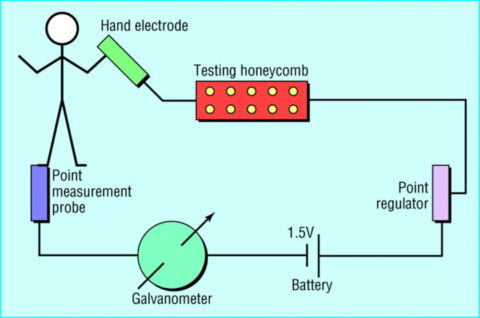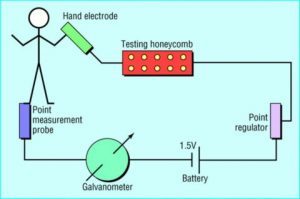This article contains affiliate links. If you make a purchase after clicking on a link I may earn a small commission at no extra cost to you.
Be Wary of Unconventional Tests and Therapies
Despite the fact that allergies are recognizable immune-system reactions, the mistaken notion continues to circulate that many or most inexplicable discomforts or vague health complaints are due to some “allergy.”
In their search for relief, ever more people blame multiple environmental factors and turn to “alternative” or unconventional therapies outside standard medical practice.
These unconventional treatments — often based on traditional oriental methods — include homeopathy, naturopathy, herbalism, hypnosis, massage therapy, acupuncture, therapeutic touch and some risky practices such as coffee enemas.
Some people have considered electrodermal testing as effective as skin prick tests for diagnosing allergies. A double blind, randomised block design study found that Electrodermal Testing cannot be used to diagnose environmental allergies.
[box]If you’re tempted to try alternative methods, remember that they have usually not been evaluated by standard scientific methods, and have not been clinically proven effective or safe.[/box]
Standard medical practice refers to “evidence-based” methods of diagnosis and therapy, based on scientific principles. Alternative or nonconventional methods of testing and treatment, although not scientifically proven safe and effective, may suit and help some people — provided they do no harm. However, check out their merits and validity before trying them.
What is Neutralization Therapy?
For example, “neutralization therapy” — which combines wide-ranging environmental avoidance and elimination diets with the use of vitamin and mineral supplements and certain salts to “neutralize” the body’s allergies — has been shown by scientific studies to improve only 4 percent of those who try it. Of the others, 44 percent remained unchanged and 52 percent found symptoms worsened.
In general, conventional medical caregivers have a wary attitude to alternative therapies, although some are beginning to endorse their use as “complementary” therapy — alongside conventional treatment, but not instead of it.
Spurred by popular interest in unorthodox therapies, many physicians now promote certain nonconventional methods in addition to traditional medical treatment. The Office of Alternative Medicine, established by the U.S. National Institutes of Health continues to examine their validity and usefulness.
However, it’s wise to thoroughly check out any unorthodox therapy you’re considering, and to discuss it with your physician, in case it could conflict with or undermine medical treatments you are receiving. Some alternative methods are of no proven value and some may be downright harmful.
Some clinical ecologists and certain environmentalists who call themselves “allergy therapists” may trade on mistaken ideas about allergy to propagate and publicize various tests and “cures” of doubtful value, some of them very time-consuming and expensive. Being cautious in using such procedures may be a good idea.
The American Academy of Allergy, Asthma and Immunology has issued statements saying that the concept of clinical ecology is an “unproven methodology” and that people considering such treatment should recognize its “experimental nature.”
During the 1980s, a popular concept of “total allergy syndrome,” or sensitivity to multiple environmental agents first dubbed “twentieth-century disease” but now called “multiple chemical sensitivity” (MCS) — led to many so-called allergy or clinical ecology treatments for a syndrome not yet proven to be either allergic or total.
Those hit by this incapacitating syndrome believed themselves “allergic” to a vast range of triggers and products, from electromagnetic fields and automobile exhaust to paint, perfume, adhesives, furnishings, carpet glue, detergents, numerous plants, food additives, cigarette smoke and virtually any item with a distinct odor.
People afflicted by MCS did (and still do) experience profound distress from minute amounts of the incriminated chemicals — well below threshold levels that bother most people. Many blamed the workplace for their ills.
Failing to obtain satisfactory medical treatment, MCS sufferers often seek help from clinical ecologists and self-proclaimed specialists in environmental medicine — sometimes traveling to distant clinics and undergoing costly therapies of unproven usefulness.
Some are advised to drink only triply distilled water, administer sublingual (under-the-tongue) “neutralizing drops” at the onset of symptoms and isolate themselves in “environmentally safe” havens within their homes. In many cases they withdraw from society entirely and spend most of their time at home, admitting only a few select visitors “free of all scents and pollutants.”
Although people with MCS frequently see themselves as victims of multiple chemical allergies, their complaints —headaches, poor concentration, thought aberrations, abdominal distention, stomach upsets, throat tightness (although the throat looks normal) and an inability to get air into the chest (but no wheezing) — lack the hallmarks of real allergic (immunological) reactions.
“The majority of people with multiple chemical sensitivity,” says one allergist, “have no evidence of environmental allergy — no elevation in IgE levels, no sign of increased mast-cell mediators (histamine, cytokines or leukotrienes), or other signs of immune-system changes. Their symptoms are vague and nonspecific.”
Some researchers have theorized that MCS could arise in certain people from nutrient deficiencies or through proximity of the brain’s limbic system to the olfactory (smell) lobe. (The brain’s limbic system is the seat of human emotions and urges — anger, love, sadness, sexual drive, self-preservation and survival.)
Whether there is any truth to these theories remains to be seen. In any case, MCS sufferers need to reduce their exposure to irritating volatile odors and organic solvents, and many benefit from counseling, nonjudgmental psychotherapy, support and stress-management advice.
Anyone considering unconventional tests or cures should try to distinguish fact from fiction, remembering that allergies arise from definable, distinct immune-system activity with a recognizable set of symptoms. Many allergists and immunologists warn people to beware of self-styled “clinical ecologists” claiming they can identify allergic triggers by unvalidated tests such as hair analysis, “skin titration” (measurement), feeling the pulse, injection of the sufferer’s own urine or “cyto-toxic” (white-blood-cell) tests.
The result of misguided trust could be a long course of unproven (and perhaps expensive) therapy, false hopes and failure to get correct diagnosis and suitable treatment. Alongside medical therapy, many unconventional therapies work well, but anyone considering their use should discuss the pros and cons with a medical caregiver.

